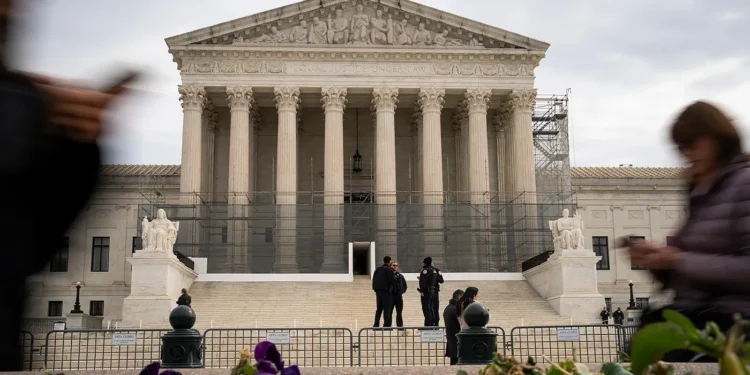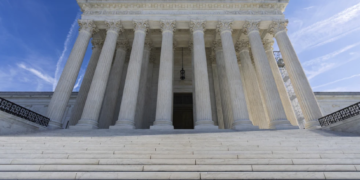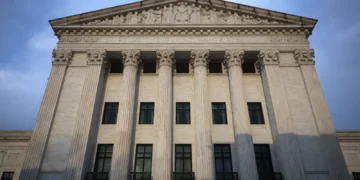June 27, 2025 Story by: Publisher
The U.S. Supreme Court is expected to issue final rulings of the current term today, June 27, including the highly anticipated decision on Louisiana v. Callais. The case, centered on Louisiana’s congressional map, could significantly impact the Voting Rights Act and redefine the role of race in electoral districting.
The case centers on whether Louisiana must create a second majority-Black congressional district, as ordered by a lower court, after finding that the current map diluted the voting strength of Black residents in violation of Section 2 of the Voting Rights Act of 1965. The high court’s ruling is expected to not only determine the makeup of Louisiana’s congressional delegation but also influence similar redistricting battles in other states.
The Legal Background
The lawsuit, brought by civil rights groups and Black voters, challenges the Republican-controlled Louisiana Legislature’s post-2020 census map, which maintains just one majority-Black district out of six, despite the fact that Black residents make up nearly one-third of the state’s population.
After the 2020 census, Louisiana needed to draw a new map for its six congressional districts. Although roughly a third of the state’s population is Black, the map that the legislature enacted in 2022 contained only one majority-Black district.
A group of Black voters challenged that map, arguing that it diluted the votes of Black residents. A federal court agreed that it likely violated Section 2 of the Voting Rights Act, which prohibits election practices that result in a denial or abridgment of the right to vote. It instructed the state to draw a new map with a second majority-Black district and barred the state from using the existing map.
The U.S. Court of Appeals for the 5th Circuit upheld that ruling and instructed Louisiana to draw a new map by Jan. 15, 2024. Without a new map by then, the court of appeals said, the district court would hold a trial and, if necessary, adopt a map for the 2024 elections.
The legislature drafted a new map, known as S.B. 8, with a second majority-Black district that begins in the northwest corner of the state near Shreveport and stretches 250 miles southeast toward Baton Rouge.
The “non-African American” voters then challenged S.B. 8. A three-judge federal district court ruled that the creation of the second majority-Black district was an unconstitutional racial gerrymander, and it barred the state from using the map in the 2024 elections.
In 2022, a federal district court found the map to be racially discriminatory and ordered the state to draw a second majority-Black district.
A divided Supreme Court put the three-judge courts’ decision on hold in May, allowing the state to use the map during the 2024 elections, and in November it set the appeal by the state and the Black voters for argument.
Louisiana officials, led by Republican Attorney General Liz Murrill, appealed, arguing that race was given too much weight in the court’s redistricting mandate, and that such race-conscious remedies risk violating the Equal Protection Clause. Their legal team contends that a second Black-majority district would require impermissible racial gerrymandering.
During oral arguments earlier this year, several justices pressed both sides on the constitutional and statutory boundaries of race in redistricting. The case arrives in the shadow of last year’s Allen v. Milligan decision, in which the Court upheld a similar order in Alabama. That precedent looms large, but with one-third of the docket still undecided and conservative justices signaling unease with federal court interventions, it remains unclear how closely the Court will hew to its 2023 ruling.
Supreme Court Justice’s perspective:
Justice Clarence Thomas was the first of several justices to press Benjamin Aguinaga, Louisiana’s solicitor general during the March session. The justice pressed advocates about whether the district court’s 2022 ruling, known as the Robinson litigation, was a sound one, so that the state was justified in relying on it to create a second majority-Black district.
Aguinaga insisted that it was. “A rational state,” he stressed, “is going to run with exactly” what the court instructed it to do.
Justice Samuel Alito chimed in, asking Aguinaga what would happen if the Robinson ruling were “plainly wrong.”
Aguinaga conceded that an “extremely unusual” case could arise in which the lower court’s ruling was “wildly wrong,” but he maintained that a case in which the lower court’s ruling was simply erroneous would be “harder to challenge” because it would essentially mean relitigating the lower court’s decision. And in any event, he added, the “non-African American” voters had not argued that the Robinson ruling was incorrect.
Justice Sonia Sotomayor jumped in on Aguinaga’s side, observing that the “non-African American” voters had instead contended that because Louisiana was trying to comply with the court order and the Voting Rights Act, race was the primary factor at issue when it drew the new map.
Justice Ketanji Brown Jackson said she was puzzled why it would matter whether the Robinson ruling was correct. She expressed concerns about the Supreme Court trying to decide, in a case like this one, whether a lower court’s ruling that is not directly before them was erroneous. The Supreme Court is traditionally constrained to only consider rulings that are appealed and directly briefed before them.
Justice Elena Kagan was equally dubious, asking whether she and her colleagues were “really in a position to address” whether the Robinson ruling was correct. “We had the opportunity to” take up that case, she noted, but “let it go.” And, she continued, the “non-African American” voters’ brief was “not premised on the idea that Robinson was incorrect.” “At some point,” she said, “a state takes its loss and decides to ‘get on with things.’” The Supreme Court has repeatedly indicated, she said that states should have “breathing room” in redistricting.
Justice Neil Gorsuch suggested that the state should not be able to rely on the Robinson decision because it was not a final decision on the merits, but instead only rulings on whether to issue a preliminary injunction. He characterized the situation as “a little awkward,” contending that the Robinson decision did not have a “binding effect.”
Sotomayor stressed that the Supreme Court had previously indicated that when states are trying to comply with Section 2, the new map that results must “substantially address” the prior violation of Section 2.
Kagan agreed. In her view, once the Robinson ruling provided Louisiana with good reason to believe that Section 2 had been violated, the only question was one of a remedy. She queried, “What’s wrong with that?” If the state cannot substantially address a violation of Section 2, she concluded, “the state has no breathing room.”
Aguinaga acknowledged that the Black voters in the Robinson litigation had provided a map that also contained two majority-Black districts. The only reason that the state departed from that map, he contended, was to protect the state’s high-profile Republican incumbents. The court has made clear that redistricting for political reasons is sound.
Edward Greim, representing the “non-African American” voters, countered that the state “always says it wants to protect incumbents.” And politics “only mattered,” he continued, because the state “accepted a second majority-Black district.” And there was no evidence in the record in this case, he emphasized, about how the state was addressing the violation. “Their entire argument was the mere existence of Robinson” means that the district can survive review.
But Chief Justice John Roberts complained that the resulting second majority-Black district was too oddly shaped to pass muster. It “runs from one end of the state to the other,” he said.
Stuart Naifeh, representing the Black voters who challenged the 2022 map, insisted that “politics is the only reason” that Louisiana chose the current map. But Roberts questioned this point, “You think race was not the basis for this district,” Roberts said skeptically. It goes from one side of the state to the other, “picking up Black populations.”
Gorsuch echoed this concern. He told Naifeh that they had been offered a map with a compact district, but “Louisiana chose a snake.” The state “didn’t have good reason to draw this district,” Gorsuch insisted. He later stressed that although “certainly politics played a role” in the state’s map, race also had factored into the map. “How,” Gorsuch asked, “do we square that with the 14th Amendment’s promise that race should play no role in our laws?”
Naifeh argued that race was just one consideration in drawing the map. Under the Supreme Court’s ruling last term in Alexander v. South Carolina Conference of the NAACP, he said, the “non-African American” voters were required to provide evidence to “disentangle race and politics,” but they failed to do so. And, he said, states are required to take population into account, not geography.
Justice Brett Kavanaugh pressed a point that he made in a 2023 concurring opinion in another redistricting case out of Alabama: Should there be a “logical endpoint” at which Section 2 of the Voting Rights Act no longer applies to race-based redistricting claims?
Naifeh countered that Section 2 violations hinge on what is currently happening with voting practices, rather than an effort to address past wrongs. It should not be tied, he argued, to an “artificial endpoint.”
Edward Greim, representing the “non-African American” voters resisted Kavanaugh’s suggestion that the court could not consider this issue because his clients had not adequately raised it. Greim maintained that the question “was not ours to forfeit.” But in any event, he added, the ruling in the Robinson decision demonstrates that Section 2 is “no longer performing the function it was assigned.”
At the end of the argument, Aguinaga urged the justices to reverse the three-judge district court’s ruling, telling them that Louisiana did not “want to be back here” before the Supreme Court “in the fall,” “defending a new map against a new challenge.” In drawing the 2024 map, he stressed the state relied on the “breathing room” that the Supreme Court’s cases promise. “And if this Court holds otherwise,” he concluded, “then respectfully I don’t know what this Court’s voting cases mean.”
Potential Consequences
A ruling upholding the lower court would reaffirm Section 2’s power to compel states to ensure minority communities have a fair chance to elect candidates of their choice—particularly in states where racially polarized voting persists. But a reversal could signal a weakening of the Voting Rights Act, further narrowing its application after the Court’s landmark Shelby County v. Holder (2013) and Brnovich v. DNC (2021) decisions.
A decision against the plaintiffs could also embolden legislatures in other states to draw maps that favor white majorities, despite growing minority populations. Voting rights advocates warn this would fundamentally erode protections for minority voters and compound historical patterns of disenfranchisement.
Political Stakes
The implications are not just legal but intensely political. A second majority-Black district in Louisiana could shift one House seat from Republican to Democratic control, a significant development given the narrow partisan balance in Congress. Similar cases are pending in Georgia, Texas, and Florida, all of which could be affected by the Court’s reasoning in the Louisiana case.
With over one-third of its docket still pending, the Supreme Court is facing mounting pressure to deliver clarity on multiple hot-button issues, including presidential immunity, social media regulation, and abortion-related restrictions. But few decisions may carry as enduring a structural impact on U.S. democracy as this redistricting battle.
As the Court nears the end of its term in late June, legal experts, lawmakers, and civil rights advocates await a ruling that could either reinforce or further dismantle the protections of one of the country’s most powerful civil rights laws.
Sources: NBC News / SCOTUSblog

















